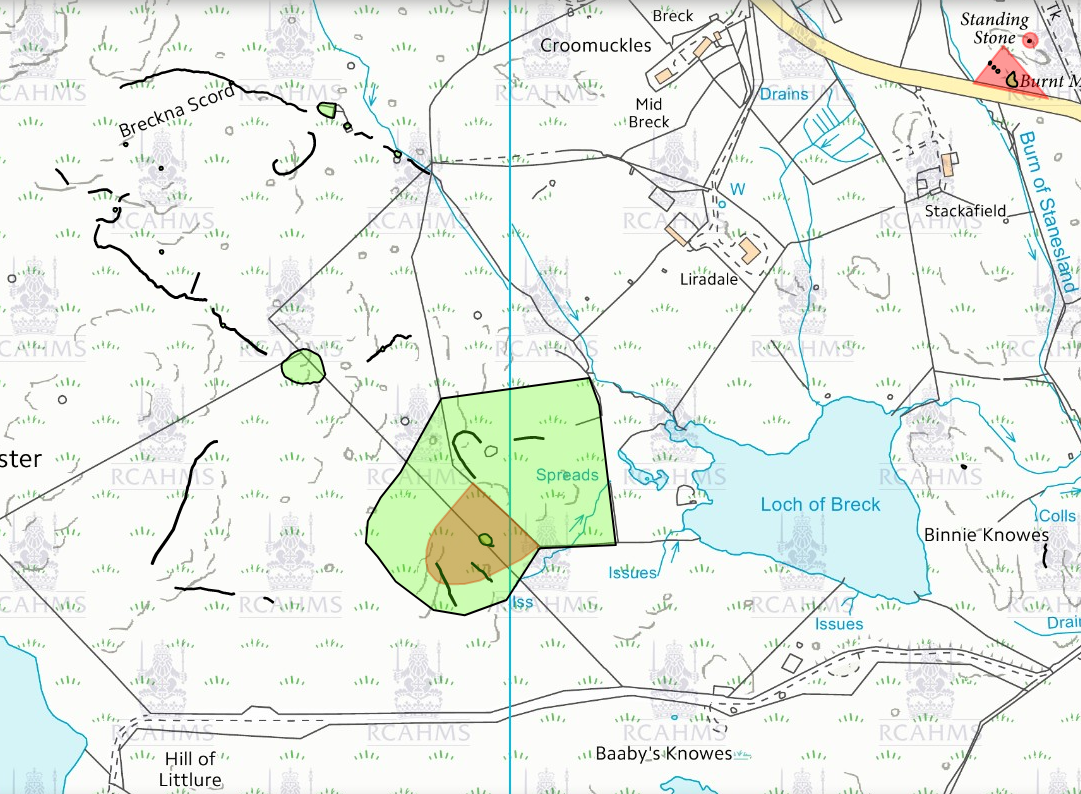Some photos from my dogwalk today at Leradale.
The Original croft house – now derelict.





The last of the flowers – all beginning to die down now. There is a real autumnal feel in the air.

One of the enclosures in the field (and small dog).

Some field terracing (possibly Bronze Age).

Old field boundaries or enclosures.

More enclosures – the inner line of rocks, not the complete line.

And again, the inner line of rocks on the left but not the “wall” – that’s modern!

The Bronze Age oval house.


(model from the Shetland Museum)


A modern-built house probably used for lambing.

Nothing changes here except for the fact I need to really read up on Bronze Age life in Shetland because, as I wander around with the dogs, I feel stupidly ignorant of the folks’ way of living.
Where the wiggly lines are, show the Bronze Age settlement.

The Historic Environment Scotlanc blurb…..
“The monument comprises the remains of a prehistoric settlement of at least one house together with the remains of contemporary fields.
The settlement is located on a NE-facing slope overlooking Loch of Breck. A single oval house has been revealed by peat-cutting. It measures some 6m by 4.5m internally, with walls up to 2m thick. The entrance has been from the SE, where a curving wall foundation suggests a porch or windbreak. Within the house, alcoves can be traced in the inner face of the wall on the NE side. To the N and NW of the house small squarish terraces probably represent contemporary fields, and there are a number of small cairns, perhaps of field cleared stones, in the area.
The area to be scheduled is irregular on plan, bounded on the NE by a modern fence, which is itself excluded. It measures a maximum of 95m NE-SW by 90m, to include the house, fields and cairns and an area around them in which traces of activities associated with their construction and use may survive, as marked in red on the accompanying map.
The monument is of national importance as a small prehistoric farming settlement which has the potential, through excavation and analysis, to provide important information about prehistoric domestic architecture and subsistence economy.”
But yet no one is interested or wants to come and have a look. We love it, though.

Amazing photos! We can all learn more about the Bronze Age.
I added a bit more info!
Truly amazing! Thanks for the photos and the fascinating glimpse into history.
I happen to have a godson who is an Iranian Azeri. He lived with us for four and a half years and I began to ask him Azeri words for things. The Azeri for bronze is branj and the Azeri for iron is hiron (with the “r” pronounced). There were many words that are found in Irish, Scots – and English – Celtic – English has some ancient Celtic words such as ash (the tree) with the Azeri for tree being aghash, Their word for mountain is dagh which is in the names of some Irish mountains and an area of Russia called Daghestan (Land of Mountains).
The steps of some Azeri dances I’ve seen in videos from Azerbaijan are like some steps in Scottish dancing, And guess what? They have tartan fabric, used by elderly ladies for shawls and it is called tarTAN. As in Irish and Celtic culture the wolf is important and is regarded as the protector of the Azeri people. Lots of other similarities … Here is a little of what I have written: ‘The Iranian Azeri word for wolf is “janavarr”, with a sound change to “canavar” in Azerbaijani. The prefix “con” or “can” in Celtic means “wolf”, as in O’Connor – where the first element means “grandson” or “descendant”; compare the Azeri for “son”: “oghlen”.’
I wrote it all up but have not been able to get anyone to follow it up so I know the feeling about no one being interested.
How fascinating.
Thanks. Yes, I think it’s quite amazing too. My godson belongs to an ethnic group in the north of Iran.
Thanks for this historic views. I’ve often wondered what the odd bits of stonework we can see in your photos were.
Thanks for such an interesting post. Living in the US doesn’t frequently afford access to such history quite as easily–especially in FL! A few indian mounds and some stele are about all this state has to offer.
I’m interested! Are you allowed to go poking around by yourself, or does it fall under some claim of archeological or anthropological protection?
When I was there, I tried to join/find a walk with a local sciencey group. It was raining, to which I paid no mind, but they apparently canceled. So I went off across fields anyway, wearing your borrowed boots, and near drowned myself in the mud. I still don’t understand how sloped peat bogs stay so wet. Fantastic day of wild adventure. I found the historical structures but wished for an interpreter. Wish I could do it again!
Excellent documentation — and the textures in the photos is marvelous. Could knit a sweater from those colors! very interesting post on many levels.
One could spend hours imagining the people and their daily living activities in and around those structures. With more historical info, might make good material for a novel. Just describing the local environment would draw you in… 🙂
I agree!